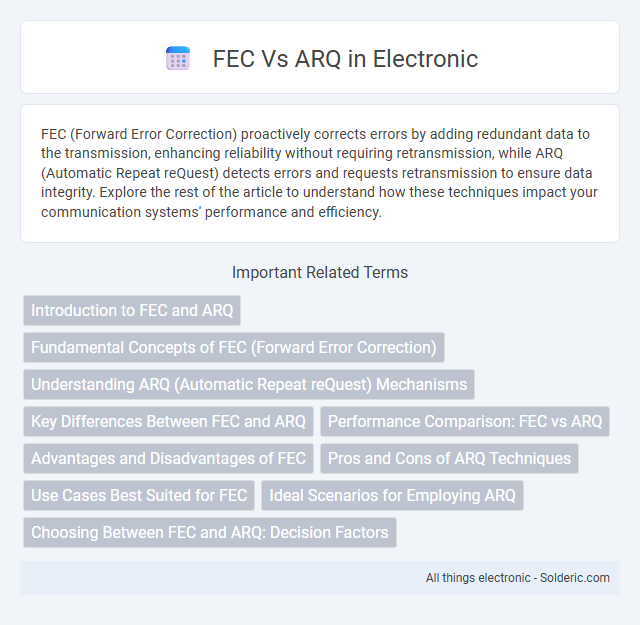FEC (Forward Error Correction) proactively corrects errors by adding redundant data to the transmission, enhancing reliability without requiring retransmission, while ARQ (Automatic Repeat reQuest) detects errors and requests retransmission to ensure data integrity. Explore the rest of the article to understand how these techniques impact your communication systems' performance and efficiency.
Comparison Table
| Feature | FEC (Forward Error Correction) | ARQ (Automatic Repeat Request) |
|---|---|---|
| Error Control | Proactive error correction by adding redundancy | Reactive error correction via retransmission requests |
| Latency | Low latency, no retransmissions needed | Higher latency due to retransmission delays |
| Bandwidth Efficiency | Consumes extra bandwidth for redundant data | Efficient unless retransmissions are frequent |
| Complexity | Complex encoding and decoding algorithms required | Simple implementation with acknowledgment protocols |
| Use Cases | Real-time streaming, satellite communication | File transfers, reliable data communication |
| Error Detection | Errors corrected without detection step | Errors detected before retransmission |
Introduction to FEC and ARQ
Forward Error Correction (FEC) and Automatic Repeat Request (ARQ) are essential error control methods in digital communication systems designed to improve data transmission reliability. FEC adds redundant data to the transmitted message, enabling the receiver to detect and correct errors without needing retransmission. ARQ relies on error detection and retransmission, where your system requests the sender to resend corrupted or lost packets, ensuring data integrity through acknowledgment.
Fundamental Concepts of FEC (Forward Error Correction)
Forward Error Correction (FEC) enables data transmission with enhanced reliability by proactively adding redundant information that allows the receiver to detect and correct errors without retransmission. This technique uses error-correcting codes, such as Hamming codes or Reed-Solomon codes, to encode the original message before transmission. By integrating FEC into your communication system, you improve data integrity and reduce latency compared to Automatic Repeat reQuest (ARQ), which relies on error detection followed by retransmissions.
Understanding ARQ (Automatic Repeat reQuest) Mechanisms
ARQ (Automatic Repeat reQuest) mechanisms enhance data transmission reliability by detecting errors and requesting retransmission of corrupted packets, ensuring accurate delivery. This technique operates with protocols like Stop-and-Wait, Go-Back-N, and Selective Repeat, each balancing efficiency and complexity in handling lost or erroneous data. Your network can benefit from ARQ by reducing data loss and improving communication robustness, especially in environments with variable error rates.
Key Differences Between FEC and ARQ
Forward Error Correction (FEC) transmits redundant data to allow error correction at the receiver without retransmission, while Automatic Repeat reQuest (ARQ) detects errors and requests retransmission of corrupted packets. FEC is ideal for real-time applications where low latency is critical, whereas ARQ offers higher accuracy by ensuring data integrity through retransmissions but with increased delay. Your choice between FEC and ARQ depends on the required balance between latency, bandwidth efficiency, and error correction reliability.
Performance Comparison: FEC vs ARQ
Forward Error Correction (FEC) offers continuous error correction without needing retransmissions, making it ideal for real-time applications and high-latency networks. Automatic Repeat reQuest (ARQ) relies on error detection and retransmission, which can increase latency but ensures higher data integrity in reliable network conditions. Your choice between FEC and ARQ depends on the required balance between latency, bandwidth efficiency, and error resilience in your communication system.
Advantages and Disadvantages of FEC
Forward Error Correction (FEC) enhances data transmission reliability by allowing error detection and correction at the receiver side without requiring retransmission, reducing latency and improving throughput in high-delay or lossy networks. Advantages of FEC include continuous data flow, reduced bandwidth usage due to fewer retransmissions, and improved performance in real-time applications like streaming and VoIP. However, FEC requires additional computational resources and bandwidth overhead for encoding redundant data, and its effectiveness depends on accurate error pattern prediction, which may not suit highly unpredictable or burst-error-prone channels.
Pros and Cons of ARQ Techniques
ARQ (Automatic Repeat reQuest) techniques improve data reliability by retransmitting corrupted packets, ensuring error correction through acknowledgment feedback. Pros include simplicity, effective error handling in noisy channels, and minimal redundancy overhead during low error rates. Cons involve increased latency due to retransmissions, potential bandwidth wastage, and reduced throughput under high error conditions.
Use Cases Best Suited for FEC
Forward Error Correction (FEC) is best suited for use cases requiring low-latency communication and where retransmissions are costly or impractical, such as live video streaming, real-time online gaming, and satellite communications. FEC's proactive error correction enables uninterrupted data flow by allowing the receiver to correct errors without the need for retransmission, which is critical in environments with high latency or limited bandwidth. This method excels in multicast or broadcast scenarios where sending acknowledgments is inefficient, making it ideal for applications demanding continuous, high-quality data delivery.
Ideal Scenarios for Employing ARQ
ARQ is ideal for scenarios with low to moderate error rates where timely and reliable data transmission is critical, such as in TCP/IP networks and real-time applications requiring error correction through retransmission. It performs best in environments with sufficient bandwidth and relatively low latency, enabling efficient detection and correction of errors by requesting retransmission of corrupted packets. ARQ is less suitable for highly lossy or latency-sensitive systems where delay caused by retransmissions would degrade performance.
Choosing Between FEC and ARQ: Decision Factors
Choosing between Forward Error Correction (FEC) and Automatic Repeat reQuest (ARQ) depends on network conditions such as latency sensitivity, error rates, and bandwidth availability. FEC is preferred in real-time applications like live streaming or VoIP, where low latency is critical and retransmissions are costly. ARQ suits environments with higher latency tolerance and reliable feedback channels, as it ensures data integrity through retransmissions when errors are detected.
FEC vs ARQ Infographic

 solderic.com
solderic.com